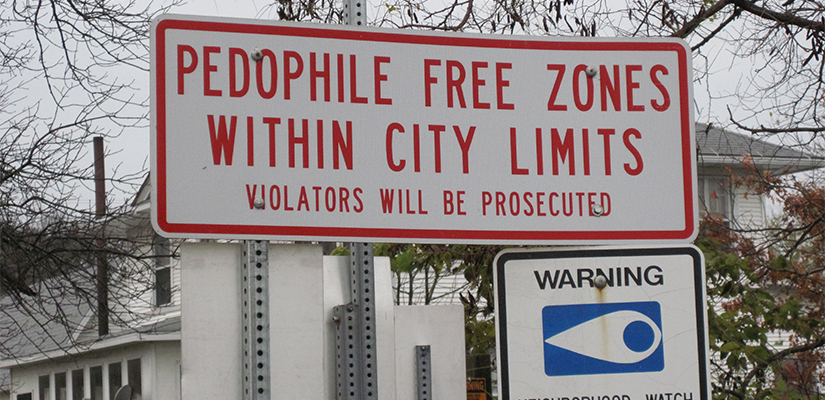There is no doubt that California laws are complicated. Anyone who has ever tried to read a “code section” or “statute” knows that the paragraphs are meticulously labeled – supposedly to make them easier to read – and in fact without the designation of paragraphs and subparagraphs it might be impossible to understand most laws.
A good example of just how complex and detailed they are is California Penal Code Section 290, affectionately entitled “Registration of sex offenders”.
This law begins “(a)(1)(A) Every person described in paragraph (2), for the rest of his or her life while residing in California, or while attending school or working in California, as described in subparagraph (G), shall be required to resister with the chief of police in the city in which he or she is residing, or the sheriff of the county if he or she is residing in an unincorporated area or city that has no police department, and, additionally, with the chief of police of a campus of the University of California , the California State University, or community college if he or she is residing upon the campus or in any of its facilities, within five working days of coming into, or changing his or her residence within, any city, county, or city and county, or campus in which he or she temporarily resides.”
That is just the first paragraph. If you look closely you see this is all one sentence. Our California lawmakers are famous for their run-on sentences and no doubt they are quite proud of this one. Notice also that this law starts with three levels of paragraph labeling and also refers to two other separate paragraph/subparagraphs of the statue.
This first paragraph does tell us what the law is about – it is about making people register with law enforcement – but who? To answer that you must read subparagraph (a)(2) which does not even appear until fourteen subparagraphs later.
Paragraph (a)(2) states “The following persons shall be required to register pursuant to paragraph (1):
(A) Any person who, since July 1, 1944, has been or is hereafter convicted in any court in this state or in any federal or military court of a violation of Section 187 committed in the perpetration, or an attempt to perpetrate, rape or any act punishable under Section 286, 288, 288a, or 289, Section 207 or 209 committed with intent to violate section 261, 286, 288, 288a, or 289, Section 220, except assault to commit mayhem, Section 243.4, paragraph (1), (2), (3), (4), or (6) of subdivision (a) of Section 261, or paragraph (1) of subdivision (a) of Section 262 involving the use of force or violence for which the person is sentenced to the state prison, Section 264.1, 266, or 266c, subdivision (b) of Section 266h, subdivision (b) of Section 266i, Section 266j, 267, 269, 285, 286, 288, 288a, 288.3, 288.5, 288.7, or 289, Section 311.1, subdivision (b), (c), or (d) of Section 311.2, Section 311.3, 311.4, 311.10, 311.11, or 647.6, former Section 647a, subdivision (c) of Section 653f, subdivision 1 or 2 of Section 314, any offense involving lewd or lascivious conduct under Section 272, or any felony violation of Section 288.2; or any statutory predecessor that includes all elements of one of the above-mentioned offenses; or any person who since that date has been or is hereafter convicted of the attempt or conspiracy to commit any of the above-mentioned offenses.”
Again, that is all one sentence – WHEWEE!! Also notice that all of the offenses are merely listed by their corresponding Penal Code Section number. So even after you read it you still wonder – who the heck is supposed to register?
To make it a little easier to understand I have broken it down and added a description to each section number.
For instance – Section 187 – Murder committed in the perpetration, or an attempt to perpetrate, rape or any act punishable under Section 286 Sodomy, 288 Lewd Acts on a Minor, 288a Oral Copulation, or 289 Sexual Penetration,
Section 207 or 209 – Kidnapping committed with intent to violate Section 261 Rape, 286 Sodomy, 288 Lewd Acts on a Minor, 288a Oral Copulation, or 289 Sexual Penetration,
Section 220 – Assault to commit rape, sodomy or oral copulation – except assault to commit mayhem,
Section 243.4, Sexual Battery – touching the intimate part of a person who is unlawfully restrained, or someone who is a patient in a medical treatment facility, unconsicious, etc.
Section 261, Rape
Section 262 Spousal Rape – involving the use of force or violence for which the person is sentenced to the state prison,
Section 264.1 – Aiding and Abetting a rape by force or violence,
266, Enticing a young female into Prostitution, or
266c, Inducing another into having sex by false pretenses involving fear
Section 266h, Pimping a Minor,
Section 266i, Pandering of a Minor (inducing the minor to become a prostitute)
Section 266j, Providing a Minor for Lewd or Lascivious acts
267, Taking a person under 18 to become a Prostitute
269, Aggravated Sexual Assualt of a child under 14
285, Incestuous Fornication or Adultery
286, Sodomy
288, Lewd and Lascivious Acts upon Minors or the Infirm
288a, Oral Copulation of Minors or the Infirm or By Force or Under
Color of Authority
288.3, Contacting or Communicating with a Minor for Illegal Sex
288.5, Continuous Sexual Abuse of a Child
288.7, Adult Sexual Intercourse or Sodomy with a Child Under 10 Years,
289, Unconsensual Sexual Penetration by Force, Violence, Threat, Duress
or Color of Authority
Section 311.1, Obscene Material Depicting Sexual Activity (or simulated
Sexual Activity) of a Person Under 18 Years
Section 311.2 (b), Child Pornography for Commercial Purposes
311.2(c) Child Pornography – possession and/or distribution whether or
not for Commercial Purposes
311.2(d) Child Pornography
Section 311.3, Sexual Exploitation of a Minor
311.4, Hiring, Employing or Using a Minor for Pornography
311.10, Advertising or Distributing Child Pornography
311.11, Possession of Child Pornography
647.6, Annoying or molesting child under 18
former Section 647a,
subdivision (c) of Section 653f, Solicitation of another to commit rape, sodomy or oral copulation by force or violence
subdivision 1 or 2 of Section 314, Lewd or obscene conduct; indecent exposure; obscene exhibitions; or
any offense involving lewd or lascivious conduct under Section 272, Contributing to delinquency of, or persuading, luring, or transporting minors 12 years of age or younger; or
any felony violation of Section 288.2 Harmful matter sent with intent of seduction of minor; or
any statutory predecessor that includes all elements of one of the above-mentioned offenses; or any person who since that date has been or is hereafter convicted of the attempt or conspiracy to commit any of the above-mentioned offenses.
And that is just the description of who must register. There is a myriad of paragraphs and subparagraphs telling how and when and where to register and what happens if you do not comply – all just a complicated as this paragraph.
If you find yourself having to deal with this, or any of the thousands of other complicated California statutes and your head starts to hurt just reading the law – then you know you need a qualified and experienced attorney to help you – if nothing else to simply be able to understand what you are facing. That of course is why we at WALLIN & KLARICH is here – to help you with your legal problem. We have many offices located through Southern California and you can speak to a qualified attorney today!



